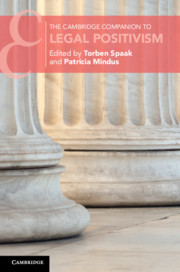Book contents
- The Cambridge Companion to Legal Positivism
- Cambridge Companions to Law
- The Cambridge Companion to Legal Positivism
- Copyright page
- Contents
- Figures
- Contributors
- Acknowledgements
- 1 Introduction
- Part I Fundamentals
- Part II History
- Part III Central Figures
- Part IV Main Tenets
- Part V Normativity and Values
- Part VI Critique
- 27 Gustav Radbruch’s Critique of Legal Positivism
- 28 Good Order and Workable Arrangements: Lon Fuller’s Critique of Legal Positivism
- 29 Dworkin’s Critique of Hart’s Positivism
- 30 Tracing Finnis’s Criticism of Hart’s Internal Point of View: Instability and the ‘Point’ of Human Action in Law
- 31 Alexy’s Critique of Legal Positivism
- 32 Mark Greenberg on Legal Positivism
- 33 Positivism and Totalitarianism
- Index
- References
30 - Tracing Finnis’s Criticism of Hart’s Internal Point of View: Instability and the ‘Point’ of Human Action in Law
from Part VI - Critique
Published online by Cambridge University Press: 21 January 2021
- The Cambridge Companion to Legal Positivism
- Cambridge Companions to Law
- The Cambridge Companion to Legal Positivism
- Copyright page
- Contents
- Figures
- Contributors
- Acknowledgements
- 1 Introduction
- Part I Fundamentals
- Part II History
- Part III Central Figures
- Part IV Main Tenets
- Part V Normativity and Values
- Part VI Critique
- 27 Gustav Radbruch’s Critique of Legal Positivism
- 28 Good Order and Workable Arrangements: Lon Fuller’s Critique of Legal Positivism
- 29 Dworkin’s Critique of Hart’s Positivism
- 30 Tracing Finnis’s Criticism of Hart’s Internal Point of View: Instability and the ‘Point’ of Human Action in Law
- 31 Alexy’s Critique of Legal Positivism
- 32 Mark Greenberg on Legal Positivism
- 33 Positivism and Totalitarianism
- Index
- References
Summary
Rodriguez-Blanco clarifies John Finnis’s objection to legal positivism in the shape of Hart’s theory, namely, that it is unstable because it uses the notion of an internal point of view, which does not have sufficient discriminatory power to distinguish between good and less good legal norms, between rational and non-rational court decisions, etc. Finnis’s view is that understanding a human action in law involves understanding what the point of the action is, that such understanding requires use of the Aristotelian focal meaning (or central case) methodology, that Hart’s internal point of view does not involve focal meaning and therefore cannot be used to understand the point of human actions, and that Hart’s theory is thus unstable. Rodriguez-Blanco argues that Anglophone legal philosophers’ focus in the past fifty years on Dworkin’s critique of Hart’s legal positivism has meant that they missed an opportunity to learn, through Finnis’s critique of Hart’s theory, about the philosophy of practical reason and the theory of action, and to contribute significantly to debates about normative questions, the nature of law and its relation to agency, reasons for action, and goodness.
- Type
- Chapter
- Information
- The Cambridge Companion to Legal Positivism , pp. 695 - 719Publisher: Cambridge University PressPrint publication year: 2021
References
- 1
- Cited by



